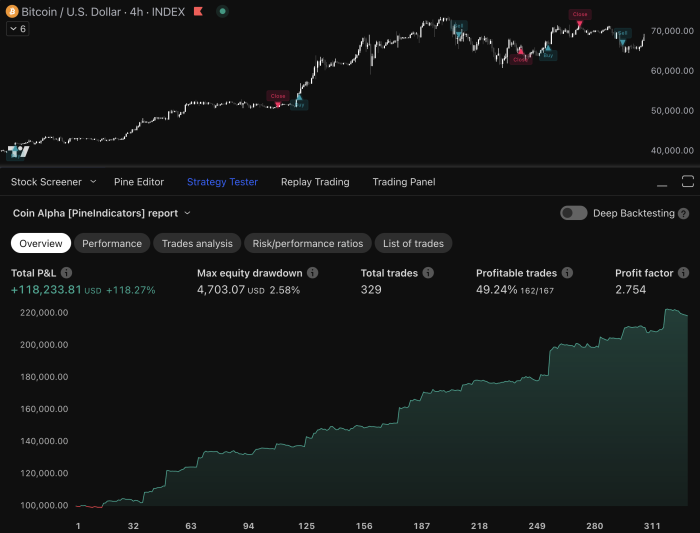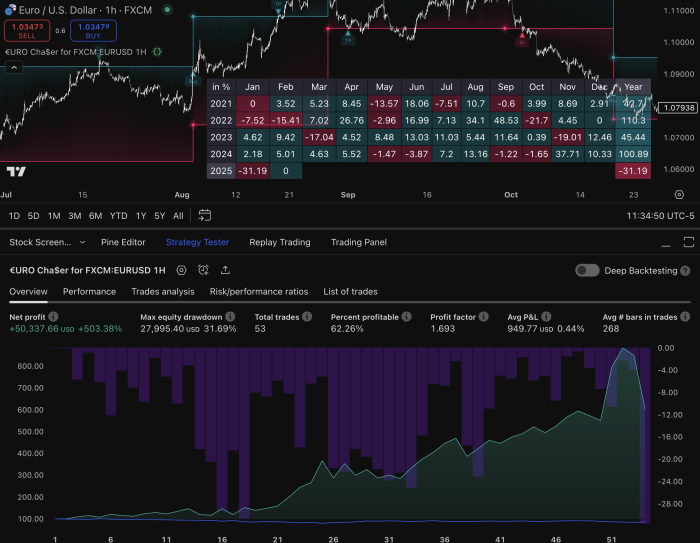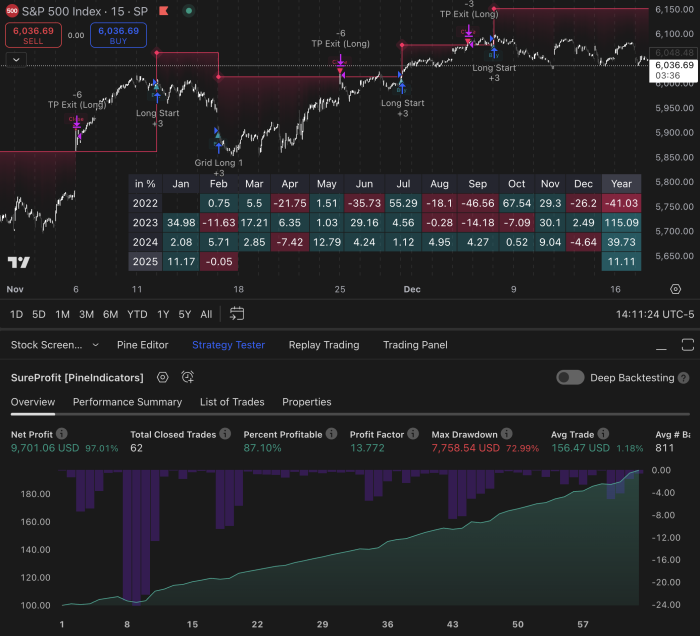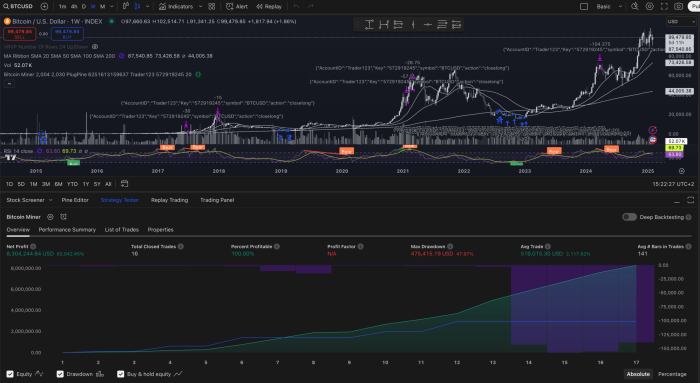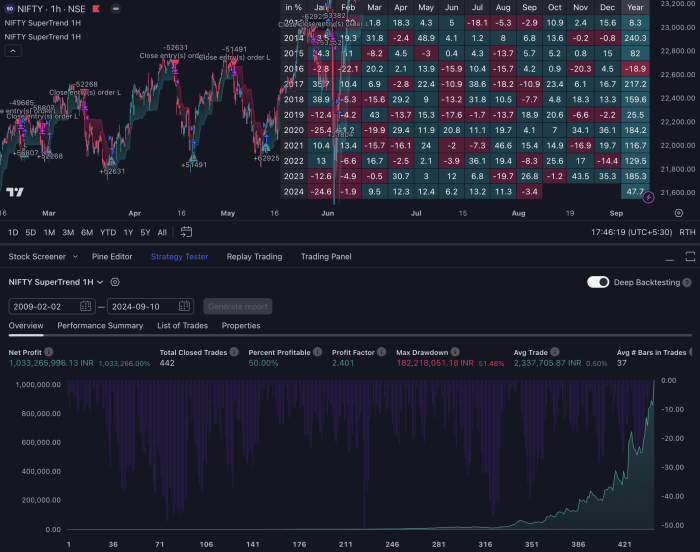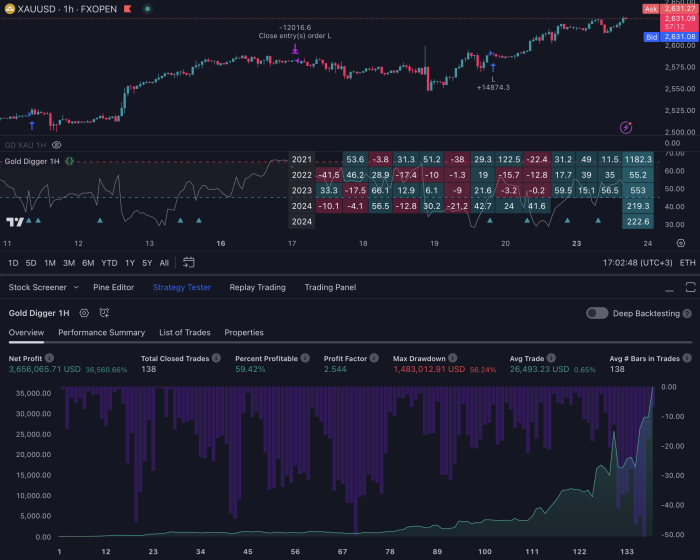Introduction
Trading automation has changed the way investors trade in financial markets. With automated trading strategies, you can execute trades accurately and consistently, without being influenced by emotions.
TradingView is leading the way in this new era of trading, offering a powerful platform for traders to create and implement their automated strategies. Using Pine Script, TradingView’s unique programming language, you can build custom indicators and trading systems that suit your specific requirements.
If you’re looking for proven automated strategies that deliver results, PineIndicators.com is a great resource. They offer a wide range of pre-built solutions that have been thoroughly tested and optimized for various market conditions.
These strategies are:
- Tested extensively in different market environments
- Designed to maximize performance
- Developed with risk management principles
- Ready to be implemented right away
Whether you’re an experienced trader wanting to expand your operations or a beginner looking to use technology for better trading results, automating your strategies on TradingView can greatly improve your trading experience.
To help you get started, here are some resources that provide ready-to-use automated strategies:
- TradingView Breakout Strategies: These strategies are designed to capitalize on significant price movements.
- Trading Signals for TradingView: Offering real-time trading signals that can enhance your decision-making process.
- Scalping Strategies for TradingView 2024: Perfect for traders who prefer making quick profits from small price changes.
- RSI Strategies for TradingView: These strategies utilize the Relative Strength Index for better trade entries and exits.
Understanding Automation in Trading
Trading automation transforms your trading strategy into a set of precise, programmable rules that execute trades automatically when specific conditions are met. Think of it as your personal trading assistant that works 24/7, following your exact instructions without deviation.
Here’s what happens behind the scenes:
- Your strategy rules, which could include best strategies for crypto trading, are converted into computer code
- The system continuously monitors market conditions
- When predefined criteria are met, trades are executed automatically
- All transactions are logged for performance tracking
The benefits of automated trading systems extend beyond mere convenience:
Increased Efficiency
- Lightning-fast execution of trades
- Ability to monitor multiple markets simultaneously
- Instant reaction to market changes
- Systematic tracking of trading performance
Elimination of Emotional Trading
- No fear-based decisions during market volatility
- Consistent execution of your strategy
- Removal of psychological barriers
- Protection from impulsive trading decisions
Risk Management
- Precise position sizing
- Automatic stop-loss placement
- Consistent trade documentation
- Portfolio diversification management
Automated trading systems excel at maintaining discipline in your trading approach. By removing human emotions from the equation, you’re able to stick to your trading plan regardless of market conditions. The system executes trades based on your pre-set parameters, ensuring each trade aligns with your strategy’s rules.
To implement these strategies effectively, understanding how to use tools like Pine Script can be incredibly beneficial.
The Role of TradingView in Strategy Development
TradingView is a comprehensive platform equipped with essential tools for successful trading strategy development. The platform’s advanced charting capabilities allow you to analyze multiple timeframes, apply technical indicators, and draw custom trendlines with precision.
Key Platform Features:
- Real-time data feeds from major exchanges
- Customizable chart layouts and workspaces
- Built-in screening tools for market analysis
- Cloud-based system accessible from any device
- Multi-timeframe analysis capabilities
TradingView offers a wide range of features that make it an ideal choice for traders looking to develop and implement their own strategies. Here are some of the key reasons why TradingView is such a valuable tool for strategy development:
- Advanced Charting Tools: TradingView provides powerful charting tools that allow you to analyze price movements, identify patterns, and make informed trading decisions. With features like multiple timeframes, technical indicators, and customizable trendlines, you have everything you need to conduct thorough technical analysis.
- Pine Script Programming Language: TradingView’s proprietary programming language, Pine Script, empowers you to create personalized trading indicators and strategies. This flexible scripting language enables custom indicator development, strategy automation, complex mathematical calculations, signal generation, and risk management implementation.
- Backtesting Capabilities: One of the most critical aspects of developing a successful trading strategy is validating its effectiveness through backtesting. TradingView’s backtesting engine allows you to test your trading ideas against historical market data, analyzing performance metrics such as win rate, profit factor, maximum drawdown, risk-adjusted returns, trade distribution, and position sizing effectiveness.
- Cloud-Based Accessibility: TradingView operates on a cloud-based system, meaning you can access your charts and strategies from any device with an internet connection. This flexibility allows you to stay connected to the markets and make adjustments to your strategies on the go.
- Community and Marketplace: TradingView has a vibrant community of traders who share their ideas and insights on the platform. Additionally, there is a marketplace where you can buy TradingView indicators or access Forex indicator scripts. This collaborative environment fosters learning and provides opportunities for enhancing your market analysis and trading strategies.
To maximize the effectiveness of your strategies, it’s crucial to backtest Pine Script strategies thoroughly before deployment in live markets. TradingView’s strategy tester provides detailed performance reports, helping you identify potential weaknesses in your trading approach. The platform allows you to adjust parameters and optimize your strategy based on historical results, ensuring robust performance across different market conditions.
The combination of advanced charting tools, Pine Script capabilities, and comprehensive backtesting features creates a powerful environment for developing and refining automated trading strategies. These tools work together to help you build reliable, data-driven trading systems that can be tested thoroughly before deployment in live markets.
As we look towards 2024, it’s worth exploring the best TradingView indicators that can significantly improve your market analysis and trading strategies.
Advantages of Using TradingView for Automation
Comprehensive Tools for Market Analysis
TradingView’s advanced charting tools, which include features such as access to over 100 built-in technical indicators and the ability to draw custom trendlines, offer traders a comprehensive suite for precise market analysis. These tools help you identify potential trading opportunities and validate your automated strategy’s entry and exit points, making them essential for implementing best entry and exit strategies in your trades.
User-Friendly Interface for Easy Automation
The platform’s user-friendly interface stands out in the trading software landscape. You’ll find intuitive navigation menus, customizable workspaces, and drag-and-drop functionality that simplifies the automation process. The clean design allows you to:
- Create and modify charts without technical expertise
- Save and organize multiple chart layouts
- Access your automated strategies across devices
- Customize indicators with simple point-and-click controls
Collaborative Learning through Community Engagement
TradingView’s vibrant community adds significant value to your automation journey. The platform hosts over 30 million active traders who share strategies, provide feedback, and collaborate on trading ideas. You’ll discover:
- Public scripts and indicators from experienced traders
- Real-time trading ideas and market analysis
- Direct feedback on your automated strategies
- Educational content from seasoned professionals
Marketplace for High-Performing Strategies
The Pine Script Marketplace serves as a hub for discovering high-performing automated strategies. You can browse through thousands of community-created indicators and strategies, both free and premium. Each script comes with detailed documentation, performance metrics, and user reviews to help you make informed decisions about incorporating them into your trading system. If you’re interested in exploring some of the top Pine Script strategies, this marketplace is a great place to start.
Reliable Cloud-Based Execution
Furthermore, TradingView’s cloud-based infrastructure ensures your automated strategies run consistently without requiring local computing resources. This reliability, combined with real-time data updates, creates an ideal environment for strategy automation across multiple markets and timeframes. With the right advanced Pine Script strategies at your disposal, you can further enhance your trading success on TradingView by implementing effective backtesting and risk management techniques.
Customizable Strategies for Crypto Trading
In addition to these advantages, TradingView also provides customizable crypto trading strategies which can be particularly beneficial in today’s digital currency market.
Integrating with Third-Party Platforms for Automation
While TradingView’s built-in features are great for analysis and strategy development, you’ll need to connect with specific third-party platforms to carry out automated trades. Tools like Optimus Flow’s Algo Strategy Builder make this process easier by turning your TradingView strategies into trading commands that can be executed.
These external solutions provide crucial capabilities for automation:
- Processing signals in real-time
- Controlling risk management
- Calculating position sizes
- Connecting to multiple exchanges
- Tracking performance
How Trading Bots Work
Trading bots function as your digital assistants, working round the clock to monitor TradingView alerts and execute trades according to the conditions you’ve set. Here’s what you can do with these bots:
- Handle multiple trading pairs at once
- Implement custom rules for entering and exiting trades
- Manage stop-loss and take-profit levels
- Keep track of important metrics related to your trades
- Generate detailed reports on each trade
The Role of API Integration
API Integration with brokers is fundamental to automated trading systems. It allows your TradingView strategies to communicate with your brokerage account securely, enabling actions such as:
- Placing orders directly
- Monitoring positions in real-time
- Managing account balances
- Handling trade confirmations
- Rebalancing your portfolio
Steps Involved in Integration
The integration process usually consists of the following steps:
- Generating API keys from your broker
- Setting up webhook notifications in TradingView
- Configuring authentication protocols
- Testing the stability of the connection
- Implementing backup mechanisms
These integrations establish a strong automated trading environment where your TradingView strategies can turn into trades without any manual effort.
For those looking to enhance their TradingView strategy development, exploring high-profit trading strategies on Pine Indicators can provide valuable insights. Additionally, understanding the best TradingView strategies for successful trading or utilizing the TradingView strategy tester can significantly improve your trading outcomes.
Furthermore, if you’re interested in customizing your TradingView scripts, seeking assistance from TradingView Pine Script experts could be beneficial. Popular platforms like Binance and Bybit also offer comprehensive API documentation to streamline the setup process for these automated trading systems.
Steps to Automate Your Strategies on TradingView
Creating a successful automated trading strategy requires a systematic approach. Here’s how you can develop your strategy on TradingView:
1. Define Your Trading Plan Rules
- Set specific entry and exit conditions
- Identify key technical indicators for your strategy
- Establish clear price action patterns
- Document your risk tolerance levels
- Specify your preferred trading timeframes
2. Translate Rules into Pine Script
- Break down complex rules into simple logical statements
- Use Pine Script’s built-in functions for technical indicators, such as the EMA Crossover Strategy
- Implement proper error handling
- Add comments to explain your code logic
- Test each component individually before combining
If you’re looking for ready-made solutions, consider exploring some automated Pine Script strategies that could save you time and effort.
3. Backtest Your Strategy
- Select appropriate historical data periods
- Test across different market conditions
- Record key performance metrics:
- Win rate
- Profit factor
- Maximum drawdown
- Average trade duration
- Compare results against benchmark indices
4. Strategy Optimization
Risk management parameters play a crucial role in your strategy’s success:
Position Sizing
- Set maximum position sizes
- Calculate risk per trade
- Implement dynamic position sizing based on volatility
Stop Loss Management
- Fixed stop loss distances
- Trailing stops
- Time-based exits
- Volatility-adjusted stops
Entry/Exit Refinement
- Fine-tune indicator parameters, possibly using some custom scripts for better results
- Adjust time filters
- Implement price filters
- Add market condition filters
You can enhance your strategy’s performance through TradingView’s strategy tester:
- Test different parameter combinations
- Analyze equity curves
- Monitor trade distribution
- Track strategy performance metrics
- Identify optimal trading sessions
Remember to validate your strategy across multiple timeframes and symbols to ensure robustness. A well-optimized strategy maintains consistent performance while adapting to changing market conditions.
Setting Up Alerts in TradingView for Trade Execution Automation
Alerts serve as the bridge between your TradingView strategy and automated trade execution. Here’s how to set up effective alerts for your automated trading system:
Creating Basic Alert Conditions
- Click the “Alert” icon on your chart
- Select “Create Alert”
- Choose your trigger conditions:
- Price crosses above/below a level
- Indicator signals
- Custom Pine Script conditions
- Volume thresholds
Advanced Alert Configuration
Your alert message structure should include:
- Entry/exit signals
- Position size
- Stop-loss levels
- Take-profit targets
- Trading pair/symbol
- Timeframe
Implementing Webhooks
Webhooks enable direct communication between TradingView and your trading platform:
- Generate a webhook URL from your trading platform
- Add the URL to TradingView’s alert settings
- Structure your alert message in JSON format
- Test the connection with a sample alert
Platform Integration Examples
Binance Integration:
json
{
“symbol”: “BTCUSDT”,
“side”: “BUY”,
“quantity”: “0.001”,
“price”: “{{close}}”
}
Bybit Integration:
json
{
“symbol”: “BTCUSD”,
“order_type”: “Market”,
“side”: “Buy”,
“qty”: 100
}
Alert Management Best Practices
- Set expiration times for your alerts
- Use specific naming conventions
- Monitor alert frequency
- Implement rate limiting
- Create backup alerts for critical conditions
The webhook system can connect to various automation platforms:
- Zapier for multi-platform integration
- Custom APIs for specialized execution
- Third-party trading bots
- Portfolio management systems
Benefits Beyond Profitability: Exploring Advantages Beyond Profits with Automated Strategies Using Data Handling Capacity & Multi-Market Management Capabilities
Automated trading systems bring powerful capabilities that extend far beyond simple profit generation. The data handling capacity of these systems transforms the way you process and act on market information.
Your automated strategy can process thousands of data points per second, identifying patterns and opportunities that human traders might miss. This enhanced data processing enables you to:
- Track multiple technical indicators simultaneously
- Monitor price movements across different timeframes
- Analyze market sentiment indicators in real-time
- Process complex statistical calculations instantly
Multi-market management capabilities allow you to expand your trading reach significantly. Your automated strategy can:
- Monitor multiple currency pairs, stocks, or crypto assets at once
- Execute trades across different exchanges simultaneously
- Maintain precise position sizing across various markets
- Apply risk management rules consistently across all trades
The scalability of automated systems proves particularly valuable during high-volatility periods. While human traders might struggle to keep up with rapid market movements across multiple assets, your automated strategy maintains unwavering attention and execution precision.
TradingView’s platform supports this multi-market approach through its comprehensive charting tools and Pine Script capabilities. You can develop strategies that capitalize on correlations between different markets, implementing sophisticated arbitrage opportunities or cross-market signals that would be impractical to execute manually.
These advanced capabilities also enable you to:
- Backtest strategies across multiple assets simultaneously
- Compare performance metrics across different markets
- Identify optimal trading conditions for each asset
- Scale your trading operations without additional manual effort
Considerations for Successful Automation with Simple Strategies First Approach & Risk Awareness Mindset
Starting your automation journey with simple strategies creates a solid foundation for long-term success. A simple strategies first approach allows you to:
- Master basic market mechanics
- Build confidence in your automation skills
- Identify and fix issues quickly
- Reduce potential financial losses during testing
Your initial automated strategy might focus on basic technical indicators like moving averages or support/resistance levels. These straightforward components provide clear entry and exit signals while helping you understand the automation process.
A risk awareness mindset serves as your safety net in automated trading. Key risk factors to consider include:
- Technical Failures
- Server downtime
- Internet connectivity issues
- Platform bugs or glitches
- Market Conditions
- Sudden price gaps
- Low liquidity periods
- High volatility events
- Strategy Limitations
- Changing market conditions
- Strategy decay
- Parameter sensitivity
Implementing proper risk management measures helps protect your capital:
- Set position size limits
- Use stop-loss orders
- Define maximum drawdown levels
- Monitor strategy performance regularly
Creating backup plans for various scenarios strengthens your automation system:
“A robust automated strategy isn’t just about profit potential – it’s about building systems that can handle unexpected market conditions while protecting your capital.”
Testing your strategies in different market conditions helps identify potential weaknesses. You can use TradingView’s backtesting features to simulate various scenarios and adjust your strategy parameters accordingly.
Remember to document all changes and observations during your automation process. This documentation becomes invaluable as you progress toward more sophisticated strategies and helps maintain consistency in your trading approach.
Conclusion
Automated trading on TradingView represents a powerful shift in how traders approach market opportunities. The platform’s robust features, combined with Pine Script capabilities, enable traders to transform their strategies into systematic, emotion-free trading systems.
The path to successful automation starts with:
- Building simple, well-tested strategies
- Leveraging TradingView’s comprehensive testing tools
- Implementing proper risk management protocols
- Using reliable third-party integrations for trade execution
One such advanced strategy you might consider is the Versatile Bollinger Band Cascade, an adaptive trading system designed to elevate your trading experience. Unlike traditional Bollinger Bands strategies, this approach integrates unique features and customization options that make it stand out in the crowded world of trading algorithms.
The future of automated trading looks promising, with continuous improvements in technology and increasing accessibility for traders at all levels. As markets evolve, the ability to automate trading decisions becomes increasingly valuable for maintaining a competitive edge.
Ready to start your automation journey? Visit PineIndicators.com to access high-performing strategies like the Versatile Bollinger Band Cascade designed specifically for TradingView. These proven strategies can serve as your foundation or inspiration for developing your own automated trading systems.
Take action now – transform your trading approach with automation on TradingView.
FAQs (Frequently Asked Questions)
What is automated trading and how does it work?
Automated trading refers to the use of computer systems to execute trades based on predefined criteria. It works by utilizing algorithms that analyze market data and make decisions without human intervention, thereby increasing efficiency and reducing emotional biases in decision-making.
How does TradingView facilitate strategy development for traders?
TradingView offers a variety of features such as advanced charting tools, a user-friendly interface, and the Pine Script programming language, which allows traders to create custom indicators and strategies. Additionally, it provides backtesting capabilities to assess the effectiveness of strategies before live trading.
What are the benefits of using TradingView for automating trading strategies?
The advantages of using TradingView include its advanced charting tools that enhance analysis, a user-friendly interface suitable for all experience levels, and a vibrant community that facilitates idea sharing and access to various indicators and strategies.
How can third-party platforms enhance TradingView’s automation capabilities?
Third-party platforms like Optimus Flow’s Algo Strategy Builder complement TradingView by enabling automatic trade execution based on defined strategies. Trading bots can act on signals generated by TradingView alerts, while API integration with brokers allows seamless trade execution from TradingView to brokerage accounts.
What steps should I follow to automate my trading strategies on TradingView?
To automate your strategies on TradingView, start by writing clear trading plan rules. Next, create a Pine Script strategy based on these rules, ensuring proper syntax. Then backtest your strategy using historical data to evaluate performance, followed by optimizing it for profitability while managing risk through techniques like stop-loss levels.
What considerations should be made for successful automation in trading?
When automating trading strategies, it’s important to adopt a ‘simple strategies first’ approach to manage complexity effectively. Additionally, maintaining a risk awareness mindset is crucial; understanding the risks associated with automated trading helps prepare for unforeseen circumstances such as technical failures or market volatility.

